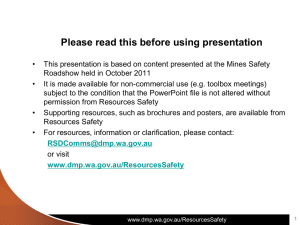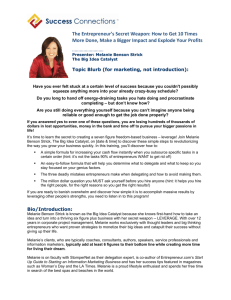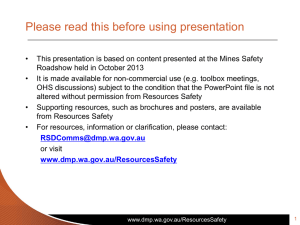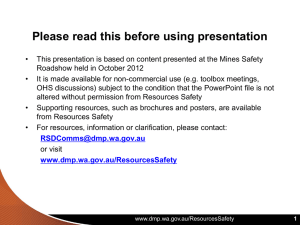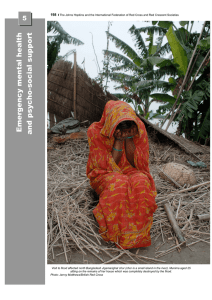Human Safety and Risk Management
advertisement
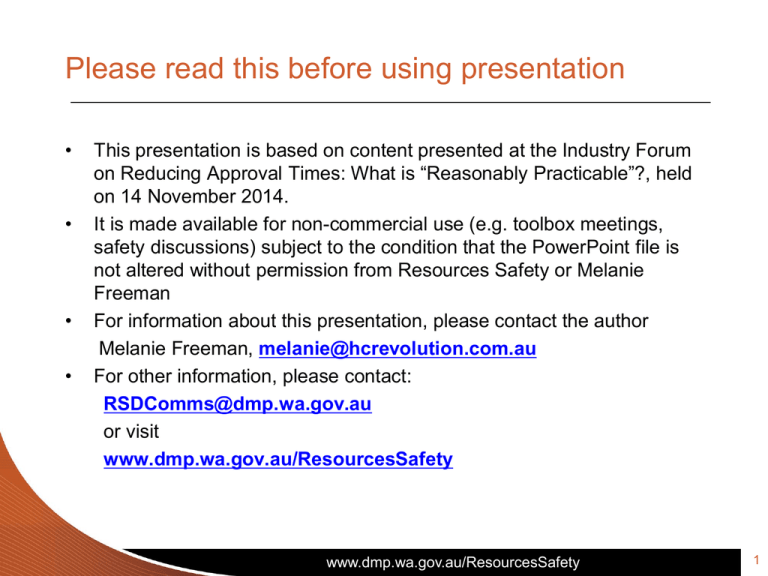
Please read this before using presentation • • • • This presentation is based on content presented at the Industry Forum on Reducing Approval Times: What is “Reasonably Practicable”?, held on 14 November 2014. It is made available for non-commercial use (e.g. toolbox meetings, safety discussions) subject to the condition that the PowerPoint file is not altered without permission from Resources Safety or Melanie Freeman For information about this presentation, please contact the author Melanie Freeman, melanie@hcrevolution.com.au For other information, please contact: RSDComms@dmp.wa.gov.au or visit www.dmp.wa.gov.au/ResourcesSafety www.dmp.wa.gov.au/ResourcesSafety 1 Human safety and risk management How to consider the people and the systems Melanie Freeman Registered Psychologist Emergency Support Network www.dmp.wa.gov.au/ResourcesSafety 2 Human Safety and Risk Management: How to Consider the People and the Systems Melanie Freeman Registered Psychologist Overview Human Safety and Risk Management Human Factors Psycho-social Factors Mental Health and Well-being Safety Culture A Model for Psycho-social Risk Management Balance of Strategies Safe Person versus Safe Place 4 Basic Models / Approaches to Risk Technical • Origins in engineering and science • Focus: physical risks • Criterion: harm Economic • Origins in mathematics, statistics and history • Focus: market risks • Criterion: utility (benefit) Cultural • Origins in social structures of trust and blame • Focus: risks socially and politically constructed • Criterion: perceived risk (attitudes/beliefs) Psychometric • Origins in human perception • Focus: perceived risk • Criterion: human behaviour, attitudes and cognitions Psycho-social Factors What do we mean by “psycho-social hazards”? Psychosocial – interactions among job content, work organization and management, and other environmental and organizational conditions that may interact with the employees’ competencies and needs (Cox, Griffiths and Randell, 2003) Interactions that are ‘hazardous’ influence employee health through their perceptions and experience (ILO, 1986) Psycho-social Factors WHS Harmonisation Legislation Important definitions in the draft legislation: hazard means a situation or thing (including an intrinsic property of a thing) that has the potential to cause injury, illness or death of a person. health means physical and psychological health. Psychosocial hazards cover: content of work its context our perceptions Examples of Psycho-social Hazards Job content Workload and work pace Work schedules Control Environment and equipment Organisational culture and function Interpersonal relationships at work Role in the organisation Career development Home and work interface Poor feedback, inadequate appraisal and communication processes Performance visibility Job insecurity, excessive work hours, bullying, managerial style (Cox, Griffiths and Randell, 2003) Attention and Vigilance Shift work and Rosters Causal Attribution Human Factors Human Error Fatigue Interface Design Stress Work-Life Balance Depression Mental Health and Wellbeing Adjustment to FIFO/DIDO Anxiety Alcohol and Other Drugs Safety Culture and Climate Behaviour Values Beliefs Assumptions Norms “the way we do things around here” NOPSEMA Safety Alert (#51) (March 2012) A Model for Psychosocial Risk Management A Framework for Psychosocial Risk Management (Leka, Cox and Zwetsloot, 2008; p. 8) Risk Management Strategies at each stage Intervention Prevention Proactive Strategies (Inoculation) Strategies for when things are impacting on people, teams and work Follow-up (Postvention) Ongoing Strategies for Support A Start Point if you want to think about any of this more Glendon, I., Clarke, S.G. and McKenna, E.F. (2006). Human safety and risk management. (2nd Ed.). New York: Taylor and Francis. 9th Managing Fatigue Conference International researchers March 2015 www.fatigueconference2015.com.au
